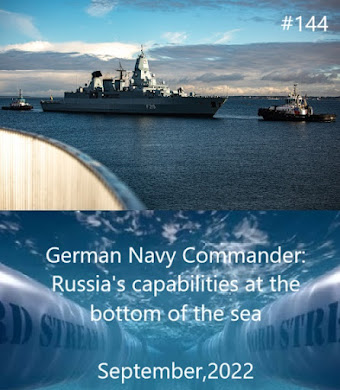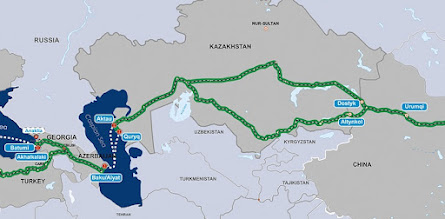In a ´theoretical´ geopolitical exercise aimed at slowing down or stalling Euro-Asian development and integration by imposing roadblocks to trade, development and intra-state economic activities, several key countries and regions could be targeted.
Is such hypothetical scenario purely speculative or grounded in real-world policies and intentions? Nonetheless, here are some potential targets that could disrupt Euro-Asian development and overview of major export countries in the region.
These are major surplus countries on Euro-Asia and weakened states.
Lines represent what I call since 2014 "Mackinder roadblocks":
How can
Euro-Asian development and integration be slowed/stopped?
Six Belt and Road Initiative corridotrs (BRI) known also as One Belt One Road (OBOR) trade corridors
Trade and development is stopped or slowed down by imposing roadblocks on these following
International Trade corridors and by weakening security in the region:
International transport corridors in Ukraine
Ukraine: Control over Ukraine's territory, particularly its eastern regions and ports such as Odessa, could disrupt trade routes between Europe and Asia, particularly maritime trade in the Black Sea region and train corridor. As a transit country between Russia and the European Union, Ukraine plays a significant role in facilitating trade flows between Eastern and Western Europe. New Eurasian Land Bridge corridor also called the Second or New Eurasian Continental Bridge was derailed and investment shifted from Russian-Ukrainian route into
Trans-Caspian International Transport Route.
Turkey: Control over the Turkish Straits (Bosporus and Dardanelles) could allow for the blocking or regulation of maritime traffic between the Black Sea and the Mediterranean, impacting trade between Europe and Asia. Disruption of this trade would be impossible at the moment as Bulgaria, Romania, and Turkey are NATO states and Turkey holds the key to this trade bottleneck in form of 1936 The Montreux Treaty.
- Caucasus
Azerbaijan: Located on the western shores of the Caspian Sea, Azerbaijan serves as a transit country for goods moving between Central Asia, the Caucasus, and Europe. The country's ports, such as Baku, are important hubs for maritime trade in the Caspian region.
Georgia: Situated in the Caucasus region, Georgia serves as a key transit route for goods moving between Europe and Asia, particularly via the Caucasus corridor. The country's ports, such as Batumi and Poti, are important hubs for maritime trade in the Black Sea region. Control over Georgia's territory and its ports on the Black Sea could disrupt maritime trade routes in the Caucasus region, impacting trade between Europe and Asia.
Armenia: Despite its small size, Armenia occupies a strategic position in the South Caucasus and serves as a transit country for goods moving between Europe, the Middle East, and Central Asia. Syria:
Syria's geographic location historically played a significant role in trade along the ancient Silk Road routes, particularly as a connecting point between the Mediterranean Sea and the rest of the Eurasian landmass. T
he ongoing conflict and political instability in Syria have severely disrupted trade and economic activity in the region. Overland trade between the Middle East and Europe through this route is more or less stalled.
- Iraq: Situated at the crossroads of the Middle East, Asia, and Europe, Iraq has long been a vital link for trade between these regions. This Iraq's geographic location has historically positioned it as a crucial trade hub along the ancient Silk Road routes. However, due to various factors such as conflict, political instability, and infrastructure challenges, Iraq's role as a trade bottleneck on the old Silk Road has been diminished in recent times. Instability on land routes connecting to Turkey and Syria has disrupt trade flows between the Middle East and Europe.
Iran: Positioned at the crossroads of the Middle East, Central Asia, and South Asia, Iran plays a crucial role in trade between Europe and Asia, particularly for goods moving by land or sea. Disruptions to maritime traffic in the Strait of Hormuz, controlled by Iran, could impact trade flows between the Persian Gulf and the Indian Ocean, affecting global energy markets and trade routes between Europe and Asia.
Afghanistan: Control over Afghanistan's territory and its major transportation routes, such as the Khyber Pass and other border crossings, could disrupt overland trade between South Asia and Central Asia, as well as between Central Asia and the Middle East.
Pakistan: Control over Pakistan's territory, particularly its ports on the Arabian Sea and land routes connecting to Central Asia and China, could impact trade flows between South Asia, Central Asia, and the Middle East.
Russia:
With its vast landmass spanning both Europe and Asia, Russia plays a pivotal role in transcontinental trade. Key transportation routes, such as the Trans-Siberian Railway and various highways, pass through Russia, making it a critical bottleneck for goods moving between Asia and Europe. Important Northern corridor, North-South transport corridor.
- Kazakhstan: As the largest landlocked country in the world, Kazakhstan occupies a strategic position in Eurasia. It serves as a transit country for goods moving between China and Europe, with key transportation routes like the Eurasian Land Bridge passing through its territory. CCAWEC provides an alternative land route route between China and Europe which avoids Russian territory.
North Korea: Disruptions to maritime traffic and trade flows in Northeast Asia, particularly through control over ports and coastlines, is impacting trade between East Asia and the rest of the world, including Europe. The frozen conflict is a roadblock for NE Asian progress and development in the region.
Taiwan: Control over Taiwan's territory and its ports could disrupt maritime trade routes in the East China Sea and South China Sea, impacting trade flows between East Asia and the rest of the world, including Europe.
SUMMARY:
Large countries on Euro-Asia: Russia, China, Iran and India are impossible to control. These sovereign countries pursuit their own sovereign interests and can not be controlled in medium to long term directly.
Several countries in Eurasia serve as significant trade route bottlenecks due to their strategic geographic location and due to the level of their transportation infrastructure.
These countries act as crucial nodes in the Eurasian trade network, and any disruptions or congestion in their transportation infrastructure can have significant implications for regional and global trade flows.
Several smaller states were lately purposefully destabilized, weakened. The maintenance of infrastructure was neglected, investments were prevented.
These ARTIFICIALLY created bottlenecks impact the flow of goods and commerce between Europe and Asia. They prevent or limit trade between surplus regions:
MACKINDER ROADBLOCKS (Artificially wakened states on old Silk Roads)
Ukraine: Ukrainian-Russian conflict
Russia: Economical and political sanctions
Caucasus: Azerbaijan-Armenian issue
Syria: Civil war
Iraq: Weak fragmented state'
Iran: Sanctioned
Afghanistan: Weakened state
Artificially induced migration as a weapon
RELATED POSTS:
[MRT: this article was since its publishing long term #1 read article on this blog]
***
***
Uncovering the truth took over two years of self-funded, tireless investigation.
I decided to open it for free, no paywall, despite huge investment.
Because the truth matters.
Please consider supporting my work with a donation.

Every bit helps keep this mission alive!
(retweet and follow)


































